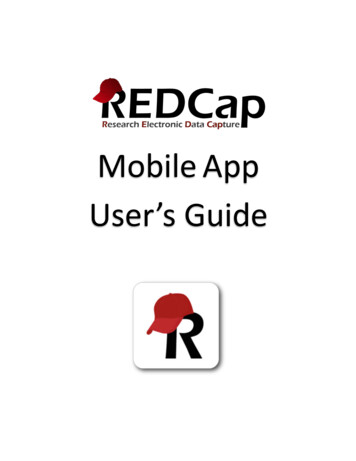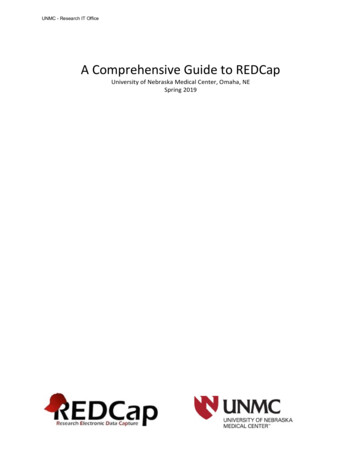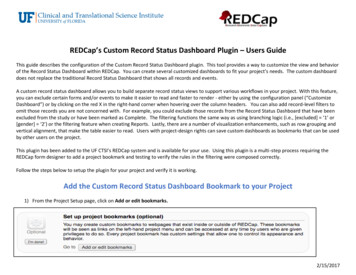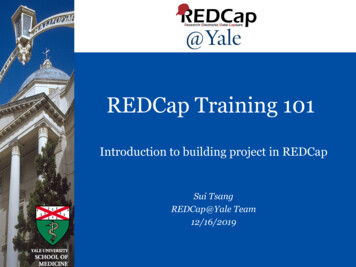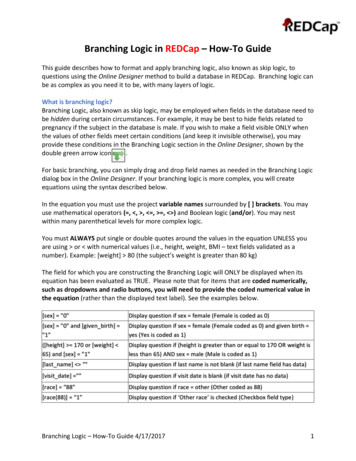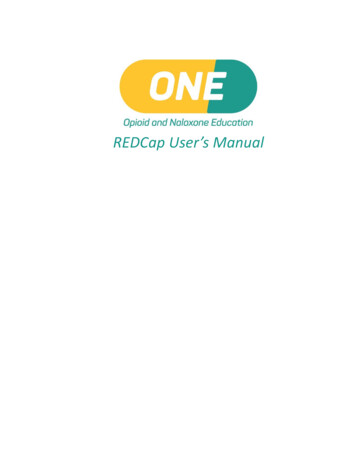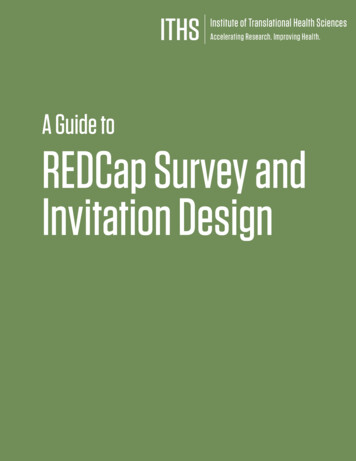
Transcription
A Guide toREDCap Survey andInvitation DesignA GUIDE TO REDCAP SURVEY AND INVITATION DESIGN1
What is REDCap?REDCap (Research Electronic Data Capture) is a secure web applicationthat supports data capture and management for research studies. ITHSis one of 1,901 institutional partners who utilize and support REDCap.How do researchers use REDCap?Researchers use REDCap for a variety of purposes, including: Administering simple recruitment surveys Collecting data for low-budget clinical trials Supporting operational activities such as class registration orevaluation Tracking adverse events Creating longitudinal studies with automatic follow-up surveys Administrating multi-site studies Eliminating double data entryHow can I learn more about REDCap?Visit one of our free monthly beginner and advanced classes or readour monthly REDCap tips and guides to learn more.SUBSCRIBE TO MONTHLYREDCAP TIPSREAD REDCAP TIPS ANDGUIDES ON ITHS.ORGA GUIDE TO REDCAP SURVEY AND INVITATION DESIGNSEE THE CLASS SCHEDULE2
PART 1The Foundational Principles ofWriting and Designing REDCapSurveysA GUIDE TO REDCAP SURVEY AND INVITATION DESIGN3
It seems simple. Write some questions. Paste them into REDCap.Hit send. Within minutes, your REDCap dashboard is full of useful,interesting data.But anyone who has written a survey knows it is not that easy. Eventhe slightest variation in survey design or question format can seriouslyimpact your results. Ask the wrong questions, or ask them in the wrongway, and you will end up with data that is unreliable or unneeded.That is why it is so important to take the time to develop surveyquestions. Good questions are the key to good data. This guidewill help you write and design REDCap surveys that engagerespondents and help you get the data you need.A GUIDE TO REDCAP SURVEY AND INVITATION DESIGN4
First, start with a goal.Before you even begin writing and designing your survey, you need toidentify your goals for the survey. What do you want to know? Who areyou surveying? How will the results be used initially? This informationwill guide the direction of your survey.For example, a survey goal may be:“To assess the satisfaction of those who attended the 2016 NationalClinical Researchers Conference.”Choose your words carefully.Now that you have identified the your goals and objectives, youcan begin writing the questions. As you write, examine how welleach question addresses the goals and objectives you haveoutlined. The following questions will help you create goal-orientedsurvey questions.Is the question necessary and/or useful?Examine each question to see if you need to ask it at all. Don’t askthe question if the response cannot be tied back to your goal. Extra,unrelated questions can lead to respondents wondering, “Why are theyasking this?”Remember that you are also asking respondents for their mostimportant commodity: time. Asking unnecessary questions can lead toA GUIDE TO REDCAP SURVEY AND INVITATION DESIGN5
a lengthy survey, which can result in lower response and completionrates.Does the respondent need more information?Look at each question to see if the respondent has the rightinformation to answer the question. For example, let’s say we ask thequestion, “Please rate your level of satisfaction with chart abstractionservices provided by the research coordinator.”If the respondent did not receive chart abstraction services, he or shewill not be able to answer this question. In this instance, we shouldadd a seed question (e.g. “Did you receive chart abstraction servicesfrom the research coordinator?”), before asking for opinions about thesession.Does the question need to be more specific?Sometimes questions can be too general, which makes data difficultto interpret. For example, let’s say we want to find out respondents’opinions about the conference’s morning group session. We could askthem:“Please rate your level of satisfaction with the morning group sessionusing a scale of ‘Extremely satisfied’ to ‘Extremely dissatisfied’.”But would that mean? What if they were satisfied with certain aspectsof the session but found other aspects lacking? Instead, you mightbreak it down into more specific sections.A GUIDE TO REDCAP SURVEY AND INVITATION DESIGN6
“Please rate your level of agreement with each statement below aboutthe morning lyDisagreeThe speaker clearly and effectively presented thematerials.The content was relevant to my professionalneeds.I learned skills or knowledge that I can apply inmy work.The learning objectives were well-covered.My knowledge/perspective on the topic wasbroadened.Overall, this session was worth my time.Please provide comments about any of theareas above, especially if you indicated youDisagreed or Strongly Disagreed with any of thestatements:Draft your survey questions.With these questions in mind, you are now ready to begin writing.As you write your survey, remember that your choice of words andphrases directly impacts the way respondents react to and interpretyour questions. Even the smallest differences can change the wayrespondents answer.The ideal survey question has three key characteristics: It has a clear purpose, measuring the underlying concept it isintended to tap. It does not measure other concepts. It is clear, concise, and means the same thing to all respondents.A GUIDE TO REDCAP SURVEY AND INVITATION DESIGN7
Keep these points in mind while drafting surveyquestions:Write questions that are simple, direct, and familiar.In general, questions that are concise, clear, and use simple languageare more easily understood by respondents.Example:Not so good: Do you use any medicines several times per week or permonth?Better: Do you regularly use medicines?Avoid using abstract terms, acronyms, and jargon.Write out acronyms or abbreviations the first time. Provide furtherdescription if needed. Use examples to help explain terms and conceptsto survey respondents.Not so good: The conference activities facilitated active learning.Better: The conference activities (e.g., break-out sessions, networkingopportunities, keynote speaker) helped keep me engaged during theconference.Make sure that responses are in a logical order and match thequestion.If you are using a rating scale, each response should be clearly higheror lower than the other for all people. Questions and responsesA GUIDE TO REDCAP SURVEY AND INVITATION DESIGN8
should also be logical matches. For example, if you are asking aboutsatisfaction, the logical scale would be “highly satisfied” to “highlydissatisfied.”Avoid these common question-writing mistakes:Double-barreled questions. To eliminate confusion, avoid askingrespondents to evaluate more than one thing, such as “Did you feelbetter after the procedure and taking the medication?” The procedureand the medication are two separate things, requiring two differentquestions. You can search for double-barreled questions in your surveyby looking for “and” or “or” in your questions.Biased questions. Make sure the wording in your questions does notlead respondents to a particular conclusion. For example, the question“Do you think that the 2016 conference offered a better variety ofbreakout session topics than last year?” drives respondents to theconclusion that the 2016 conference offered more. Instead, create amore neutral question and answers:How do you feel about the 2016 conference breakout session optionscompared to last year’s options?( ) The 2016 conference offered a better variety( ) The 2015 conference offered a better variety( ) The selections were similar( ) No opinionA GUIDE TO REDCAP SURVEY AND INVITATION DESIGN9
Loaded and leading questions. Avoid using loaded, emotionalterms in questions. For example, consider the question: “Exercising ona regular basis can be challenging. Did the intervention help you stickto a regular workout routine?” To avoid bias and leading, write moreneutral questions, such as:The intervention helped me exercise on a regular basis.( ) Strongly agree( ) Agree( ) Disagree( ) Strongly disagree( ) No opinionOverlapping responses. Make sure multiple choice options aremutually exclusive. Response options are not mutually exclusive ifa potential answer fits more than one of the response options. Forexample: “What is your current age? A.) 10 or less B.) 10 to 20 C.) 20to 30 D.) 30 or greater”Determiner. Avoid asking questions that use terms such as always,never, and only. In the question “Do you always take your medicationon time?” a respondent who missed one dose would have to answerno.A GUIDE TO REDCAP SURVEY AND INVITATION DESIGN10
Question Writing Takeaways Always link your questions to survey goals and objectives.Keep questions simple, concise, and free of acronyms and jargon.Ask about one thing at a time to avoid double-barreled questions.Avoid biased and leading questions.Make sure multiple choice options are mutually exclusive.Avoid using words like never, always, and only.If possible, use more close-ended questions than open. Close-endedquestions are easier to answer and analyze.Plan the order and flow of your survey.Once the questions are developed, attention should be paid to howthey are ordered. Like a conversation, survey questions should begrouped by topic and unfold in a logical order.For example, in our survey for conference attendees, there is a lotwe want to know about: morning and afternoon sessions, keynotespeakers, networking, and so forth.If you mix topics throughout the survey, you will end up confusing andfrustrating your respondents. Instead, break your survey into obvioussections. At the beginning of each, offer a quick introduction, such as,“This section asks questions about the morning breakout sessions.”A GUIDE TO REDCAP SURVEY AND INVITATION DESIGN11
Tips for Ordering Survey Questions Effectively Start with broad, general questions and move into more specificquestions. Sensitive or difficult questions should be asked later in the survey,after previous questions have established rapport with therespondent. Save demographic questions for the end, unless you need to askthem first to screen respondents for the survey. Use chronological sequences when obtaining historical data orsurveying about events. Make sure all questions about a topic have been addressed beforemoving on to the next topic. Use transitions to move between topics.Take time to test your survey.When you have finished creating your survey, test it thoroughly. Makesure the survey design, branch logic, and settings are working properly.Running a test before you send can prevent headaches down the roadand ensure you get the data you need.As you test it, think about the survey as if you are respondent. Are thedirections clear? Are the questions concise? Were there any confusingquestions or response options? How long did it take to complete thesurvey? Once you have successfully completed your test survey, you areready to distribute.A GUIDE TO REDCAP SURVEY AND INVITATION DESIGN12
PART 2The 4 Principles of CreatingSurvey Invitations that BoostResponse RatesA GUIDE TO REDCAP SURVEY AND INVITATION DESIGN13
You always want the highest response rate possible when conductinga REDCap survey. But sometimes getting recipients to even open youremail can be a challenge.Think about it: the average person receives 85 emails everyday. That is an avalanche of work emails, promotions, newsletters, andstuff from random companies we do not remember giving our email to.Somehow your survey invitation needs to cut through the inbox clutter,grab your recipients’ attention, and convince them to complete thesurvey. This guide outlines four fundamentals that will helpincrease the likelihood of rising above the clutter and gettingrecipients to open and respond to your survey.A GUIDE TO REDCAP SURVEY AND INVITATION DESIGN14
Write a winning subject line.Before study participants can complete your survey, they first need toopen the email invitation. You have only a few precious seconds tocatch their attention and stand out from the hundreds of other emailsin their inbox. The best email subject lines are usually short,descriptive, and provide a reason to open your email.Keep subject lines short. Most readers will quickly scan the subjectline before deciding to open the email. Aim for 50 characters or less.Be clear and concise. Subject lines that are too cute or clever arelikely to be ignored. Instead, quickly summarize what is inside. Forexample, “Share Your Thoughts on Participate in Research – Win a GiftCard” summarizes what it is (a survey about Participate in Research)and what the recipient could receive for completing the survey (giftcard). Note that you would need prior approval from your InstitutionalReview Board to reference the gift card.Avoid spam words. To keep your email out of the junk bin, avoidusing words like “free” and writing in Caps Lock.Don’t make it all about you. Avoid lines like, “Reminder tocomplete our survey” and “Help us improve our customer service.”Notice the use of our and us? These lines are all about the sender. Yoursubject line should speak directly to your readers’ interests.A GUIDE TO REDCAP SURVEY AND INVITATION DESIGN15
Give recipients a deadline. If your survey is time-sensitive, usewords that give a sense of urgency. Inspire recipients to take actionimmediately.Don’t forget the From field. Recipients need to know at first glancethat the sender is a trusted and known source. When deciding on theFrom field, you have three choices: an individual’s name, organizationname, or a combination of the two. Think about your audience andwhat they will best respond to. If you decide to use an individual’sname, use a name your recipients will recognize.Craft a compelling invitation.Now that you have mastered your subject line, you need to craft acompelling invitation within your email. It should be similar to yoursubject line: clear, concise, and relevant to the reader.Your message should include these components: Start with a personalized greeting, if possible. Several studies havefound that personalization boosts survey response rates. Learn howto add recipients’ names to invitations in REDCap. Let your contacts know why they have been asked to participate.If they previously agreed to or expressed interest in being part ofresearch, gently remind them. Tell them how you will use the results (e.g., for a research study,A GUIDE TO REDCAP SURVEY AND INVITATION DESIGN16
to make a decision). Mention how participating in the survey willbenefit the recipient. Indicate how long the survey takes to complete. Try to use concretenumbers like 3 to 5 minutes, rather than subjective terms like“short” or “brief.” Create urgency with a deadline, if needed. Guide users to the next step (taking your survey) with a clear callto-action. It should be more descriptive than “click here.” Instead,utilize action verbs (e.g., Take the Survey, Share your Feedback).Let’s put these points together in an example:Dear Jane,Thank you for using ITHS’ Participate in Research tool. We appreciateyou choosing our website for your study recruitment needs.To help us improve, we would like to ask you a few questions aboutyour experience. The survey takes 4-5 minutes to complete, and youranswers will help ITHS make Participate in Research an even better toolfor you and the research community.Share Your Feedback Now [Link to survey URL]Thank you,ITHSA GUIDE TO REDCAP SURVEY AND INVITATION DESIGN17
Send the email at the best time.With your subject line and invitation written, you are now ready tosend the invitation. But when should it go out? The best times and daysto send emails is a heavily researched—and heavily debated—topic.Most studies come up with the same conclusion: it depends.First, what day of the week should you send emails?Studies from email marketing services MailChimp, Customer.io, andGetResponse found that most activity happens in the middle of theweek. The data suggested that Tuesdays were the best day to sendemail and had the highest open and click rates. Thursday came in aclose second. While no study found Wednesday to be the most popular,it came in second place in some of the studies.What is the best time to send email?The same studies found varying results for the best time to send email.Several studies concluded that between 9 and 11 a.m. is the best timeto send email. A couple studies found there may also be a peak inopens during the afternoon as people finish work, clean out their emailinbox, or start looking for distractions.Let your recipients guide your send times.These guidelines are a good place to start, but they will not helpyou if you do not know your audience. Are you trying to reach busyinvestigators who only check email over lunch? Or parents who areA GUIDE TO REDCAP SURVEY AND INVITATION DESIGN18
busy during the day and read email late at night? Adjust your emailtiming to match your audiences’ schedule.Remind participants with strategic follow-ups.Once you have sent your initial invitation, communication withrecipients should not end.Remember that your recipients have busy lives. If you have not receivedtheir survey within 10 days, send them a friendly reminder. REDCapoffers the survey reminder feature, which is a great way to remind yourrespondents to complete a survey without having to manually re-sendinvitations. Learn how to send survey invitation reminders.You may also want to thank your respondents or send any pertinentinformation about the survey they just completed. REDCap can do thatautomatically. Learn how to create confirmation emails.A GUIDE TO REDCAP SURVEY AND INVITATION DESIGN19
How-To Personalize Your REDCap SurveysReady to boost your response rates by adding recipients’ names tosurvey invitations? Here’s how.REDCap’s piping feature allows you to display any entered variable,such as someone’s name, in the invitation, throughout the survey itself,or in the thank you message at the end.To use the Piping function in REDCap: Look up the Variable Name of the first name field in the survey (i.e.,“first name”). Go to the location of the text in which you want to “pipe” theinformation. For example, “Survey settings for the Thank youmessage,” or “Field label for other variables.” Enter your text in the chosen location. For example, “Thank you,[first name]!” or “[first name]’s Date of Birth.” Hit the save button.That’s it!A GUIDE TO REDCAP SURVEY AND INVITATION DESIGN20
How-To Send Reminders to RespondentsThe Survey Reminder function is a great way to automatically remindyour respondents to complete a survey without having to manually resend invitations.To set a reminder, navigate to the Compose Survey Invitations popupon the Participant List page.Alternatively, invitations can be set in the Automated Survey Invitationspopup in the Online Designer.A single reminder can be scheduled to be sent at an exact date andtime. Users can also schedule up to five reminders to be sent accordingto a set time schedule, such as a recurring time lapse (e.g., every12 hours after the original invitation) or on a specific day and timerecurrence (e.g., every day at 10 a.m. after the original invitation, everyMonday at 4 p.m.).Once a survey is completed, any unsent reminders are erased and notsent.A GUIDE TO REDCAP SURVEY AND INVITATION DESIGN21
How-To Send Automatic Confirmation EmailsSending an automatic confirmation email after a respondent completesa survey is an easy, effective way to thank the respondent and send anyfollow-up information. Here’s how to do it.Note: You should create the confirmation emails before you send thesurvey to respondents.First, navigate to the Survey Settings page in the Online Designer.The email confirmation setting allows you the option of adding oneattachment to the email. You can also use piping in the email’s subjectline and in the message itself to help personalize the email.A GUIDE TO REDCAP SURVEY AND INVITATION DESIGN22
About ITHSThe Institute of Translational Health Sciences isdedicated to speeding science to clinical practice forthe benefit of patients and communities throughoutWashington, Wyoming, Alaska, Montana, Idaho, andbeyond.ITHS promotes the translation of scientific discovery topractice by fostering innovative research, cultivatingmulti-disciplinary research partnerships, and ensuringa pipeline of next generation researchers throughrobust educational and career development programs.ITHS reaches beyond the Seattle area, servingeveryone involved in translational research in thefive-state WWAMI (Washington, Wyoming, Alaska,Montana, and Idaho) region. Since forming in 2007,ITHS has worked with more than 6,500 investigatorsat nearly 200 organizations across the WWAMI region.A GUIDE TO REDCAP SURVEY AND INVITATION DESIGN23
Start writing and sendingsurveys that get responses.Now that you know how to write, design, and send well-crafted,relevant, and useful surveys, it’s time to put your knowledge to work.REDCap can help you: Build and administer online surveys anddatabases quickly and securely at nocost. Input data from anywhere in the worldover a secure web connection. Create projects and report formswithout the need for a programmer. Get the responses and data you need.START CREATING REDCAPSURVEYSA GUIDE TO REDCAP SURVEY AND INVITATION DESIGN24
Take time to test your survey. When you have finished creating your survey, test it thoroughly. Make sure the survey design, branch logic, and settings are working properly. Running a test before you send can prevent headaches down the road and ensure you get the data you need. As you test it, think about the survey as if you are respondent .
